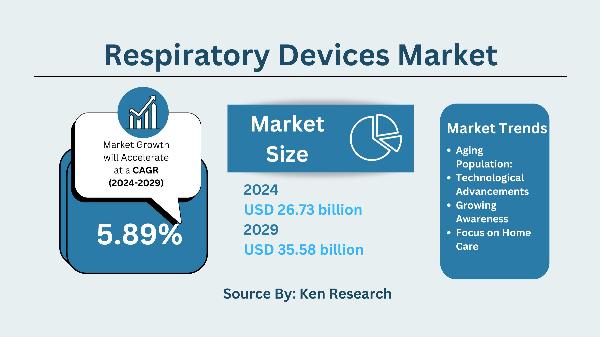The $ 35.58 Billion Respiratory Device Market with Opportunities and Challenges

Strong 8k brings an ultra-HD IPTV experience to your living room and your pocket.
Healthy lungs are the cornerstone of a healthy life. Thankfully, advancements in medical technology have brought forth a diverse range of respiratory devices that play a vital role in aiding individuals with breathing difficulties and improving respiratory health.
The Global respiratory devices market size is estimated at USD 26.73 billion in 2024, and is expected to reach USD 35.58 billion by 2029, growing at a CAGR of 5.89% during the forecast period (2024-2029).
Growth Drivers
This remarkable growth can be attributed to several key factors:
- Rising Prevalence of Respiratory Diseases: Conditions like asthma, chronic obstructive pulmonary disease (COPD), and sleep apnea are on the rise globally, driving demand for respiratory devices.
- Aging Population: The increasing population of senior citizens, who are more susceptible to respiratory issues, fuels market growth.
- Technological Advancements: The development of new and more effective respiratory devices, such as portable nebulizers and high-flow nasal cannula (HFNC), expands treatment options.
- Growing Awareness: Increased public awareness about respiratory diseases and the benefits of early intervention is leading to greater utilization of these devices.
- Focus on Home Care: The growing trend towards home-based respiratory care creates a demand for user-friendly and portable devices.
Segmentation of the Respiratory Devices Market
The global respiratory devices market can be segmented based on various factors:
- Device Type: This segment encompasses a wide range of devices, including nebulizers, inhalers, mechanical ventilators, oxygen concentrators, and sleep apnea therapy devices.
- Application: The market caters to various respiratory conditions, including asthma, COPD, cystic fibrosis, sleep apnea, and acute respiratory distress syndrome (ARDS).
- End-User: The market serves both in-hospital and home-based settings, with a growing demand for user-friendly and portable devices for home care.
- Technology: This segment encompasses devices utilizing different technologies, such as jet nebulization, metered-dose inhalers (MDIs), and continuous positive airway pressure (CPAP) machines.
Opportunities in the Respiratory Devices Industry
The respiratory devices market presents several exciting opportunities for growth and innovation:
- Telehealth Integration: Integrating respiratory devices with telehealth platforms can facilitate remote monitoring and improve patient care management.
- Personalized Medicine: The development of devices that can personalize treatment based on individual needs and genetic profiles holds immense promise.
- Focus on Early Detection: The market can benefit from the development of affordable and accessible devices for early detection of respiratory diseases.
- Wearable Technology Integration: Integration of respiratory monitoring capabilities with wearable devices can provide continuous data collection and insights into lung health.
- Emerging Markets: The growing healthcare infrastructure and rising disposable income in developing countries present significant market potential.
- Focus on Sustainability: The development of energy-efficient and environmentally friendly respiratory devices will be crucial moving forward.
Challenges
Despite its promising future, the respiratory devices market faces some challenges:
- High Costs: High initial costs of some respiratory devices, particularly advanced ventilators, can limit accessibility for some patients.
- Reimbursement Issues: Complexities in insurance reimbursement for respiratory devices can create barriers for patient access.
- Need for Skilled Personnel: The effective use of some respiratory devices requires trained healthcare professionals, which can be a limitation in certain regions.
- Counterfeit Products: The presence of counterfeit respiratory devices can pose safety risks and undermine market trust.
- Cybersecurity Concerns: Increased connectivity within respiratory devices raises concerns about data security and potential cyberattacks.
Conclusion
The respiratory devices market plays a crucial role in improving respiratory health outcomes globally. By addressing the existing challenges and capitalizing on the identified opportunities, this market can continue to develop innovative solutions that ensure everyone has access to the tools they need to breathe easier. Collaboration between manufacturers, healthcare providers, and policymakers will be essential to ensure affordable, accessible, and effective respiratory devices are available to those who need them most. As the market evolves, we can expect to see even more sophisticated and user-friendly devices emerge, empowering individuals to manage their respiratory health more effectively and live fuller lives.
Note: IndiBlogHub features both user-submitted and editorial content. We do not verify third-party contributions. Read our Disclaimer and Privacy Policyfor details.







